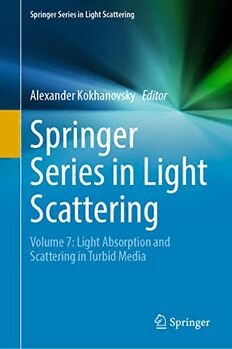
Springer Series in Light Scattering: Volume 7: Light Absorption and Scattering in Turbid Media PDF
Preview Springer Series in Light Scattering: Volume 7: Light Absorption and Scattering in Turbid Media
Springer Series in Light Scattering Alexander Kokhanovsky Editor Springer Series in Light Scattering Volume 7: Light Absorption and Scattering in Turbid Media Springer Series in Light Scattering SeriesEditor AlexanderKokhanovsky,VITROCISETBelgium,ALeonardoCompany, Darmstadt,Germany EditorialBoard ThomasHenning,MaxPlanckInstituteforAstronomy,Heidelberg,Germany GeorgeKattawar,TexasA&MUniversity,CollegeStation,USA LevPerelman,HarvardUniversity,Cambridge,USA KnutStamnes,StevensInstituteofTechnology,Hoboken,USA GraemeStephens,NASAJetPropulsionLaboratory,LosAngeles,USA BartvanTiggelen,J.FourierUniversity,Grenoble,France ClaudioTomasi,InstituteofAtmosphericSciencesandClimate,Bologna,Italy The main purpose of SPRINGER Series in Light Scattering is to present recent advancesandprogressinlightscatteringmediaoptics.Thetopicisverybroadand incorporatessuchdiverseareasasatmosphericoptics,oceanoptics,opticsofclose- packedmedia,radiativetransfer,lightscattering,absorption,andscatteringbysingle scatterersandalsobysystemsofparticles,biomedicaloptics,opticalpropertiesof cosmicdust,remotesensingofatmosphereandocean,etc.Thetopicisofimportance for material science, environmental science, climate change, and also for optical engineering.Althoughmaindevelopmentsinthesolutionsofradiativetransferand lightscatteringproblemshavebeenachievedinthe20thcenturybyeffortsofmany scientists including V. Ambartsumian, S. Chandrasekhar, P. Debye, H. C. van de Hulst,G.Mie,andV.Sobolev,thelightscatteringmediaopticsstillhavemanypuzzles tobesolvedsuchasradiativetransferincloselypackedmedia,3Dradiativetransfer as applied to the solution of inverse problems, optics of terrestrial and planetary surfaces,etc.Alsoithasabroadrangeofapplicationsinmanybranchesofmodern scienceandtechnologysuchasbiomedicaloptics,atmosphericandoceanicoptics, andastrophysics,tonameafew.ItisplannedthattheSerieswillraisenovelscientific questions,integratedataanalysis,andoffernewinsightsinopticsoflightscattering media. Moreinformationaboutthisseriesathttp://www.springer.com/series/15365 Alexander Kokhanovsky Editor Springer Series in Light Scattering Volume 7: Light Absorption and Scattering in Turbid Media Editor AlexanderKokhanovsky TelespazioBelgium Darmstadt,Hessen,Germany ISSN2509-2790 ISSN2509-2804 (electronic) SpringerSeriesinLightScattering ISBN978-3-030-87682-1 ISBN978-3-030-87683-8 (eBook) https://doi.org/10.1007/978-3-030-87683-8 ©TheEditor(s)(ifapplicable)andTheAuthor(s),underexclusivelicensetoSpringerNature SwitzerlandAG2021 Thisworkissubjecttocopyright.AllrightsaresolelyandexclusivelylicensedbythePublisher,whether thewholeorpartofthematerialisconcerned,specificallytherightsoftranslation,reprinting,reuse ofillustrations,recitation,broadcasting,reproductiononmicrofilmsorinanyotherphysicalway,and transmissionorinformationstorageandretrieval,electronicadaptation,computersoftware,orbysimilar ordissimilarmethodologynowknownorhereafterdeveloped. Theuseofgeneraldescriptivenames,registerednames,trademarks,servicemarks,etc.inthispublication doesnotimply,evenintheabsenceofaspecificstatement,thatsuchnamesareexemptfromtherelevant protectivelawsandregulationsandthereforefreeforgeneraluse. Thepublisher,theauthorsandtheeditorsaresafetoassumethattheadviceandinformationinthisbook arebelievedtobetrueandaccurateatthedateofpublication.Neitherthepublishernortheauthorsor theeditorsgiveawarranty,expressedorimplied,withrespecttothematerialcontainedhereinorforany errorsoromissionsthatmayhavebeenmade.Thepublisherremainsneutralwithregardtojurisdictional claimsinpublishedmapsandinstitutionalaffiliations. ThisSpringerimprintispublishedbytheregisteredcompanySpringerNatureSwitzerlandAG Theregisteredcompanyaddressis:Gewerbestrasse11,6330Cham,Switzerland Contents Light-Absorbing Particles in Snow and Ice: A Brief Journey AcrossLatitudes .................................................. 1 B.DiMauro, R.Garzonio, G.Baccolo, S.Gilardoni, M.Rossini, andR.Colombo Machine Learning Based Retrieval Algorithms: Application toOceanOptics ................................................... 31 LipiMukherjee RadiativePropertiesofNon-sphericalBlackCarbonAerosols ......... 69 JieLuo,QixingZhang,YongmingZhang,andZhengqiangLi Scattering of Shaped Beams by Large Particles: Theoretical InterpretationandNumericalTechniques ............................ 125 KuanFangRenandJianqiShen Index ............................................................. 159 v Light-Absorbing Particles in Snow and Ice: A Brief Journey Across Latitudes B.DiMauro,R.Garzonio,G.Baccolo,S.Gilardoni,M.Rossini, andR.Colombo Abstract Worldwide,snowandicecanbepollutedwithimpuritiesalsoreferredas Light-AbsorbingParticles(LAPs).Inthischapter,wereviewthedifferentprocesses occurringatmiddlelatitudes,tropicalareas,andpolarregions.Weshowthatsnowand icealbedoreductionduetoLAPsdepositionorresurfacingisaglobalphenomenon withregionalcharacteristics.Laterinthechapter,weprovideaclassificationofLAPs based on their optical features. We divided LAPs in non-carbonaceous (mineral dust) and carbonaceous (biogenic particles and cryoconite), and we created a set of radiative transfer simulations for each category. Lastly, we described different observationapproachesforstudyingLAPsimpactonsnowandice.Wedividedthese methods in proximal (field spectroscopy) and remote (aerial surveys and satellite data)sensing.WeexpectthatthestudyofLAPsinsnowandicewillgrowinthefuture, and more data and models will be developed in order to describe the hydrological andclimaticeffectofLAPsinthecryosphere. · · · · · Keywords Snow Ice Radiativetransfer Lightabsorption Lightscattering · · · · · · · Albedo Cryoconite Dust Glacier Algae Biogenicparticles HCRF Field · · · · spectroscopy UAV LAPs Satellite Carbonaceousaerosol 1 Introduction The impact of light-absorbing particles (LAPs) on the optical properties of snow andicehasbeeninvestigatedindifferentmountainchainsandpolarareas.Several studieshavebeenfocusingonthestudyofthisprocessthroughthedevelopmentof radiativetransfermodelsthatincludetheroleofLAPs.Inparallel,fieldspectroscopy B B.DiMauro( )·S.Gilardoni InstituteofPolarSciences,NationalResearchCouncil,Milan,Italy e-mail:[email protected] R.Garzonio·G.Baccolo·M.Rossini·R.Colombo DepartmentofEarthandEnvironmentalSciences,UniversityofMilano-Bicocca,Milan,Italy G.Baccolo NationalInstituteofNuclearPhysics(INFN),SectionofMilano-Bicocca,Milan,Italy ©TheAuthor(s),underexclusivelicensetoSpringerNatureSwitzerlandAG2021 1 A.Kokhanovsky(ed.),SpringerSeriesinLightScattering,SpringerSeries inLightScattering,https://doi.org/10.1007/978-3-030-87683-8_1 2 B.DiMauroetal. andremotesensingdatawereusedtomeasuretheimpactofLAPsonthereflectance spectrumofsnowandice(Cooketal.2020a;DiMauroetal.2017;Painteretal.2013, 2016).LAPscanundergobothshort-rangeandlong-rangeatmospherictransportand theycanbedepositedonsnow-andice-coveredregions.WhiletheimpactofLAPs in the atmosphere depends on particle properties and the albedo of the underlying surface,whenLAPsarepresentinsnoworicetheyincreasetheabsorptionofsolar radiation, and induce a positive surface radiative forcing (Skiles et al. 2018). This mechanismtriggersthesnowalbedofeedbackthateventuallyleadstomoreenergy absorptionandsurfacemelting(Bondetal.2013;Flanneretal.2007;Painteretal. 2012a). For this reason, the scientific community that investigates the impact of climatechangesonthecryospherehasbeeninterestedinquantifyingtheimpactof LAPs on seasonal snow, mountain glaciers and ice sheets in the last decades (Di Mauro2020). While the deposition of atmospheric particles on snow has the general effect of decreasing the albedo, the mechanism, timing and intensity of the process is highlyvariableindifferentgeographicalregionsofplanetEarth(Dumontetal.2020; Di Mauro et al. 2019). In fact, midlatitude glaciers and snow fields are impacted by aerosol transport from arid and hyper arid areas, tropical glaciers are strongly affectedbyLAPsdepositionfrombiomassburningintheAmazonbasin(Magalhães etal.2019).Inthischapter,webrieflyreviewthedifferenttypesofLAPsthatcan impactonsnowandiceatglobalscale.Wepresentaclassificationofcarbonaceous (black carbon, brown carbon, snow algae, glacier algae and cryoconite) and non- carbonaceous (mineral dust) LAPs, and we describe the different effect that these particlesexertonsnowandiceopticalproperties.Infact,themineralogical,chemical, andbiochemicalcompositionofLAPsproducesdifferentsignaturesonthespectral reflectance of snow and ice. This feature allows to discriminate different types of impuritiesfromhyperspectraldatacollectedfromairborneandspacebornesensors. 2 AJourneyAcrossLatitudes Inthissection,webrieflydescribethemostimportantresearchfindingsfromdifferent latitudesworldwide.Weidentifythreemainsectionsasafunctionofthegeographical location of the reviewed research. Section 2.1 focuses on middle latitude studies, Sect. 2.2 on tropical glaciers and snow fields, and finally Sect. 2.3 describes the resultsfromnorthandsouthpolarstudies(Fig.1). 2.1 MiddleLatitudes Snowandiceatmid-latitudecanbeimpactedbyaseriesofprocessesthatinducea surfacedarkeningandpossiblypromotethemelting.InEurope,seasonalinputfrom theSaharadesertcandepositLAPsintheAlps(DiMauroetal.2019),inthePyrenees Light-AbsorbingParticlesinSnowandIce… 3 Fig.1 Globalmapdividedintropicalareas,middlelatitudesandpolarregions (Peyetal.2020)andalsotheCaucasus(Dumontetal.2020).Aerosoldepositions have been stored in alpine ice cores both in the Alps (Sodemann et al. 2006) and in Caucasus (Kutuzov et al. 2019), and are useful for studying past climate and environmental variability. Saharan dust plumes can travel thousands of kilometers intheatmosphereandreachsnow-andice-coveredareas.Snowlayersinterestedby dustdepositionsareoftenburiedbynewsnowandresurfacedattheendoftheseason whentheyexertastrongsnowalbedofeedback(Tuzetetal.2020). Similar processes occur also in High-Mountain Asia (HMA) (i.e. the Tibetan Plateau,centralAsianmountainsincludingtheHimalaya,Karakoram,TienShan,and Pamir)wheretheuplift,transportanddepositionofLAPshavebeenidentifiedasan importantcontributiontocryospheredemise(Kangetal.2020;Quetal.2014;Zhang etal.2018).SeveralstudieshavebeenpublishedonthecharacterizationofLAPsin surfacesnowandiceinHMA(Congetal.2018;Lietal.2016,2017a;Ménégozetal. 2014;Nairetal.2013;Zhangetal.2018).Intheseareas,thecontributionofnatural and anthropogenic particles is difficult to disentangle (Kang et al. 2020). Global remotesensingdatahavebeenusedforprovidingasynopticviewofthesnowand icedarkeningprocessesinHMA,andrecentresultssuggestedaprominentinfluence ofdustonsnowdarkeningwithrespecttoblackcarbon(Sarangietal.2020). Important studies regarding the impact of disturbed desert soil on snow albedo have been performed in Western United States (Painter et al. 2007, 2010). Field spectroscopyandsatellitedatahavebeenintegratedwithadvancedsnowmodeling forassessingtheimpactofmineraldustonthepropertiesofsnow.Resultsshowed thatthepresenceofmineraldustinsnowinduces areductionofsnowcover upto 51days(Skilesetal.2012). In the non-tropical Andes few observations are available regarding the surface concentrationofLAPsinseasonalsnowandglaciers.Recentfindingsrevealedthat inChileanAndesLAPsaredominatedbymineraldustratherthanBC(Roweetal. 2019). FewstudieshavebeenconductedonLAPsinsnowandiceinAlaska,butmost of them focus on the impact of snow algae on the optical properties of snow. In particular,SPOTandLandsat-8satellitedatahavebeenusedformappingthespatial 4 B.DiMauroetal. distribution and radiative forcing of red snow algae (Ganey et al. 2017; Takeuchi etal.2006). Glacier and snow fields in New Zealand can be also impacted by deposition of LAPs. During the 2019–2020 season, the extreme wildfires activity in Australia deliveredlargequantitiesofaerosoltoNewZealandinducingastrongdecreasein albedo(Puetal.2021). 2.2 TropicalAreas Morethan95%oftropicalglaciersarelocatedinthetropicalAndes,whilesomeof them are situated in East Africa and Indonesia (Veettil and Kamp 2019). Glaciers intheTropicalAndesarepotentiallyimpactedbyBlackCarbon(BC)andOrganic Carbon(OC)emissionsfromopenburninginSouthAmerica,duetoforestfiresand agricultural activities (slash-and-burn practice) (Bourgeois et al. 2015; Magalhães et al. 2019). Open burning typically peaks during the dry season in the southern hemisphere (August–September) and during the wet season in the northern hemi- sphere (February) (Chuvieco et al. 2008). Soil re-suspension of mineral dust due to agriculture, construction, mining, and transportation activities can contribute to LAPsinglacierareas,aswell(Schmittetal.2015).Onlyalimitednumberoffield observationscharacterizesnowLAPsinthetropicalAndeanglaciers.Schmittetal. (2015)observedthatBCdominatesLAPsabsorptionintheCordilleraBlancaglaciers nearbyurbanizedenvironments,whiledustcontributionismoreprominentinremote regions. DepositionofmineraldustfromminingactivitiesinIndonesiamightcontribute, together with climate change, to the retreat of ice-covered areas on Puncak Jaya (Veettiletal.2018). 2.3 PolarRegions Polarregionsareoftenthoughtaspristine.Whilethisislargelytruefortheinternal areas of large ice sheets (Polashenski et al. 2015), the margins of ice sheets (i.e., Greenland and Antarctica) can be affected by several snow and ice darkening processes(Bøggildetal.2010).Intheseareas,bothatmosphericdeposition(Thomas etal.2017)andresurfacingofLAPs(Wientjesetal.2011)canoccur.Moreoverit should be remembered that glacial activity is among the most efficient processes that produce mineral dust available for deflation and high latitude dust represents asignificantpartoftheglobalatmosphericdustcycle(Bullard2013;Bullardetal. 2016). TheGreenlandiceSheet(GiS)experiencesstrongseasonalchangesinthealbedo (Tedesco et al. 2016). In fact, during winter GiS is characterized by highly reflec- tivefreshsnow,butduringsummermeltingoccursonthemarginsleavingbareice
